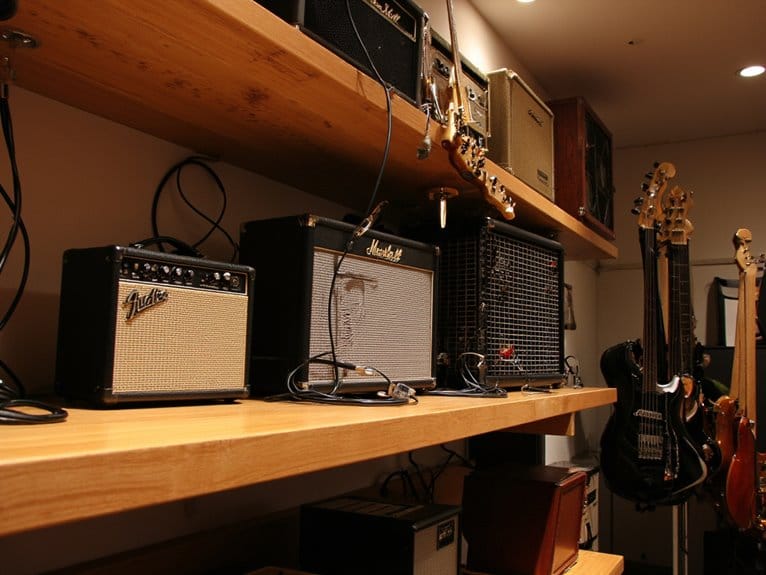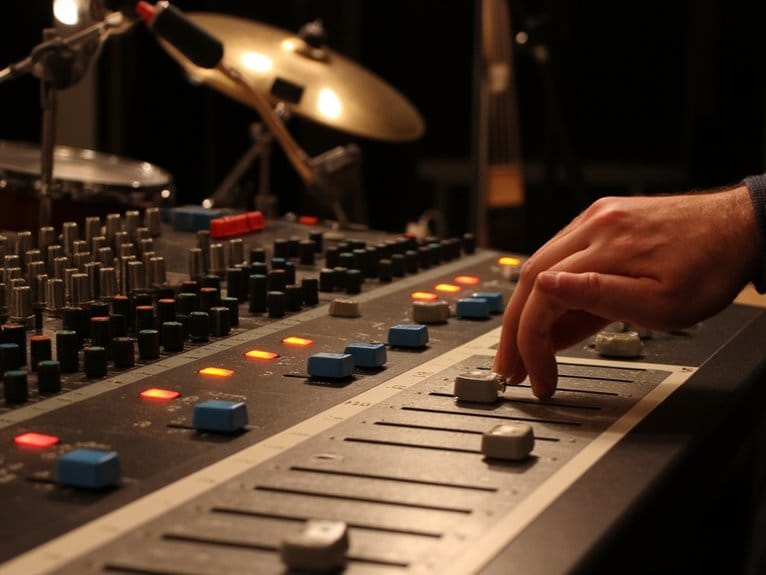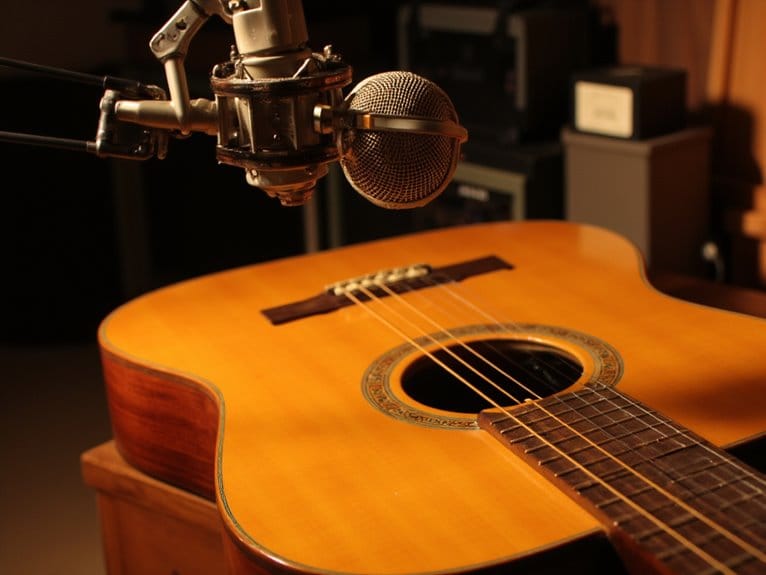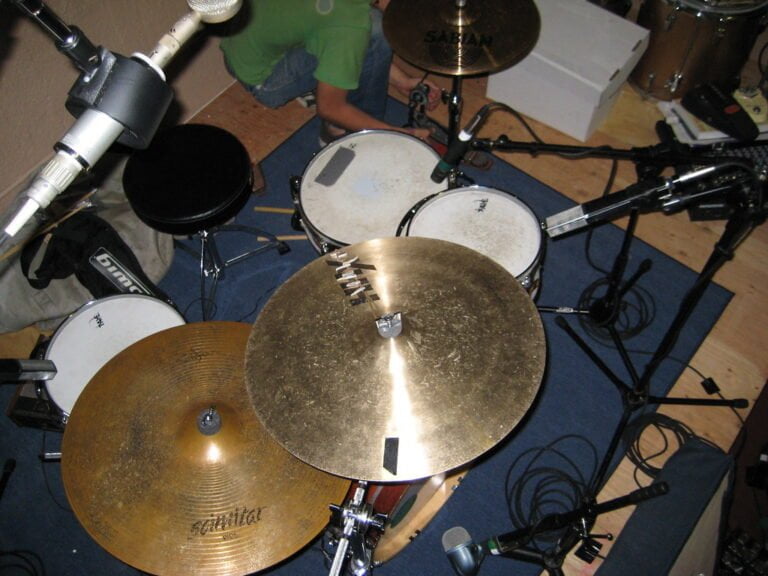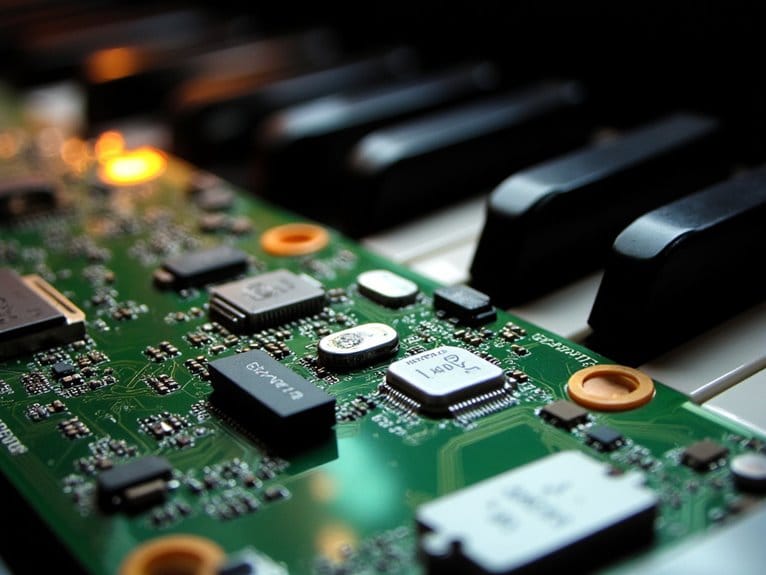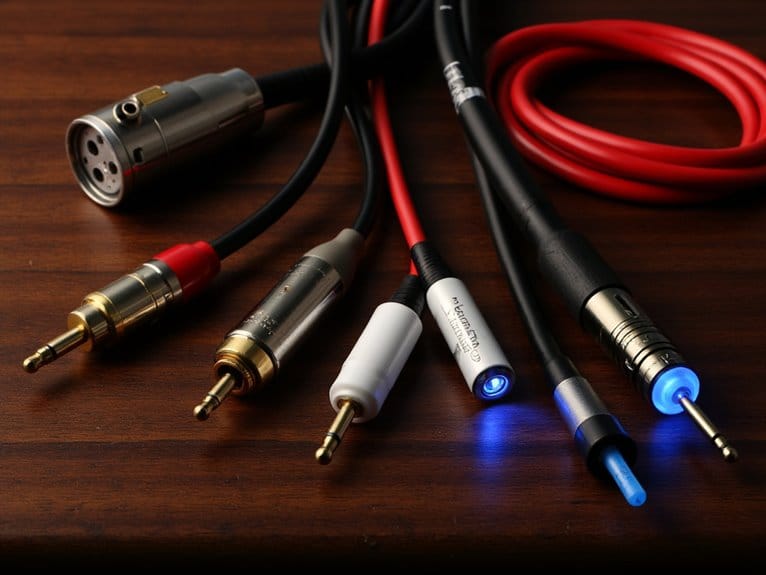Choosing Your First Guitar Amplifier: Beginner’s Guide
When you’re choosing your first guitar amplifier, you’ll encounter three main types: tube amps that deliver warm, naturally distorted tones but require more maintenance, solid-state models using transistors for clean, reliable sound, and modeling amps that digitally emulate hundreds of classic amplifiers in one unit. Your budget typically ranges from $50-300 for entry-level options, though mid-range amplifiers between $300-750 offer better digital modeling and connectivity features. Essential beginner features include standard guitar input, headphone output for silent practice, intuitive tone controls, and 10-50 watts of power for adequate volume without overwhelming your space. Popular starter models include the portable Boss Katana Mini X, versatile Fender Champion II 25, and the preset-rich Fender Mustang LT25, each offering respectable sound quality for learning while accommodating different practice environments. Understanding these fundamentals will help you navigate the technical specifications and performance metrics that determine which amplifier best suits your playing goals. When selecting an amplifier, consider how you’ll primarily use it—whether for home practice, recording, or performing live. Many beginners find that using headphones for guitarists can enhance their practice sessions by allowing them to hear their playing more clearly and without disturbing others. Additionally, investing in a good set of headphones can further elevate your sound experience, especially with amplifiers that feature dedicated headphone outputs.
We are supported by our audience. When you purchase through links on our site, we may earn an affiliate commission, at no extra cost for you. Learn more.
Notable Insights
- Start with entry-level amps ($50-$300) that include essential features like headphone outputs for silent practice.
- Choose 10-50 watt combo amps for adequate volume and portability without overwhelming beginners.
- Prioritize user-friendly controls and connectivity options like AUX input for jamming with backing tracks.
- Consider modeling amps like Fender Mustang LT25 for extensive preset libraries and tone experimentation.
- Budget for accessories like cables and pedals, which can add $15-$2,000 to your total cost.
Understanding Different Types of Guitar Amplifiers
When I first started playing guitar, I’ll admit I was completely overwhelmed by the sheer number of amplifier options available, and honestly, the technical jargon didn’t help much either.
Understanding the tube vs solid state debate becomes clearer once you know that tube amps deliver warm, naturally distorted tones through vacuum tubes, while solid-state amps use transistors for clean, precise sound with better reliability. Tube amplifiers offer warm, rich tones that are particularly great for blues and rock styles, though they do require more maintenance than their solid-state counterparts. Solid-state amps provide dependable performance and power efficiency for regular gigging, making them an excellent choice for beginners who need consistent reliability.
Modeling amps digitally emulate various classic amplifiers, offering hundreds of tones in one unit, making them perfect for beginners exploring different sounds. Digital amps excel in variety, providing everything from vintage Fender cleans to high-gain Marshall distortion at the touch of a button.
Hybrid amplifier advantages include combining tube preamp warmth with solid-state power efficiency, giving you the best of both worlds without the full maintenance headaches of traditional tube amplifiers. Speaker configurations can also dramatically impact your overall tone, so consider this factor when evaluating different amp options.
Setting Your Budget and Price Expectations
Although I initially thought I could get away with buying the cheapest amp possible, I quickly learned that setting a realistic budget requires understanding how your playing goals align with price ranges and feature sets.
Entry-level amps typically cost $50 to $300, which covers basic practice needs but limits tonal versatility and performance capabilities.
Mid-range options spanning $300 to $750 offer digital modeling, effects, and USB connectivity that support diverse practice scenarios.
Your budgeting strategies should factor in accessories like cables and pedals, adding $15 to $2,000 to total costs.
Price factors include wattage requirements, tube versus solid-state circuitry, and intended usage contexts, whether home practice, rehearsals, or small gigs, ensuring your investment matches realistic playing aspirations.
For budget-conscious beginners, quality amplifiers under $200 provide good sound quality for practice while including essential features like headphone outputs and EQ controls. Additionally, 10-15 watt combos deliver the classic warmth ideal for home use without overwhelming your practice space. Pairing these amplifiers with quality guitar practice headphones can enhance your experience, allowing you to fully immerse yourself in your sound without disturbing others. Many amplifiers in this range also offer compatibility with various effects pedals, further expanding your creative options. This versatility makes them an excellent choice for beginners looking to refine their skills and explore different musical styles.
Essential Features Every Beginner Should Consider
Once you’ve established your budget boundaries, the next step involves identifying which amplifier features will actually serve your learning journey rather than simply impressing you in the store.
Essential input options include a standard 6.3mm guitar jack and headphone output for silent practice, which honestly saved my sanity during apartment living. User friendly controls matter more than flashy features—look for intuitive tone controls with basic bass, mid, and treble adjustments that won’t overwhelm your developing ear.
Consider these core amplifier connectivity features:
- AUX input for jamming along with backing tracks
- Built in effects like reverb for enhanced sound depth
- Clean/gain channel switching for tonal versatility
Power ratings between 10-50 watts provide adequate volume while maintaining portability features that accommodate practice sessions and potential jam situations. Clear labeling of controls enhances ease of use and reduces setup confusion during your early learning stages. Modern amplifiers increasingly feature Bluetooth connectivity which allows you to wirelessly stream backing tracks and play along with your favorite songs during practice sessions.
Top Amplifier Models for New Players
Three distinct categories of amplifiers dominate the beginner market, each offering unique advantages that’ll shape your learning experience and practice routine. Mini amps like the Honeytone N-10 and Boss Katana Mini X deliver exceptional portability with surprising sound quality, while combo amps such as the Fender Champion II 25 provide classroom-appropriate volume levels. Modeling amps, including the Fender Mustang LT25, offer extensive preset libraries for tone experimentation. For apartment dwellers, consider low-wattage options with headphone jacks that enable silent practice sessions without disturbing neighbors.
| Amp Model | Key Advantage |
|---|---|
| Honeytone N-10 | Ultimate portability with belt clip |
| Boss Katana Mini X | Strong tone in compact design |
| Fender Champion II 25 | Perfect bedroom-to-rehearsal power |
| Positive Grid Spark Mini | App integration for modern learning |
| Orange Crush Mini | Classic brand tone accessibility |
When conducting amp comparisons, I’ve found that sound quality often surprises newcomers—even budget options deliver respectable performance for learning fundamentals. Premium amplifiers feature metal construction and advanced electronics that provide enhanced durability and superior tone shaping capabilities for long-term musical development.
Maintenance Tips and Long-Term Considerations
Finding the perfect beginner amplifier represents just the beginning of your musical journey, and I’ve learned through years of guitar teaching that proper maintenance determines whether your amp delivers consistent performance for decades or becomes a frustrating source of crackling sounds and diminished tone quality.
Effective amp cleaning starts with regular dust removal using soft cloths, avoiding abrasive chemicals that damage finishes. For tube maintenance, you’ll need to monitor bias settings and replace tubes when sound quality degrades.
Essential maintenance practices include:
- Store your amp in dry, cool environments away from heat sources
- Allow two-minute warm-up periods before playing, especially with tube models
- Use contact cleaners like DeOxit on input jacks to reduce crackling
Professional servicing becomes necessary when you notice volume fluctuations or intermittent noises indicating internal component issues. When recording your amplifier for practice sessions or demos, consider that professional audio interfaces offer superior sound quality with specifications like 24-bit/192kHz converters and ultra-low-noise preamps.
Frequently Asked Questions
Do I Need an Amplifier if I Have an Electric Guitar?
Yes, you’ll need an amplifier for your electric guitar. Electric guitar necessity includes audible sound since guitars are nearly silent unplugged. Amplifier features like volume control and tone shaping are essential for proper practice and performance.
What’s the Difference Between Combo Amps and Separate Head and Cabinet?
Combo amps integrate amplifier and speaker for grab-and-go convenience, while head cabinet advantages include modularity and tonal flexibility. Combo amp benefits center on simplicity and matched components, whereas separate systems offer customization options.
Can I Connect My Phone or Computer to Play Backing Tracks?
You can connect your phone or computer to most modern amps using AUX inputs with 3.5mm cables, Bluetooth connectivity for wireless streaming, or audio interfaces that route both guitar and backing tracks through your setup.
On a final note
You’ve now got the essential knowledge to make an informed amplifier purchase that’ll serve you well through countless practice sessions. Remember, your first amp doesn’t need to be perfect—it just needs to inspire you to keep playing. Start with something reliable within your budget, focus on the fundamentals we’ve covered, and don’t overthink it. Your playing will evolve, and so will your gear preferences over time.

